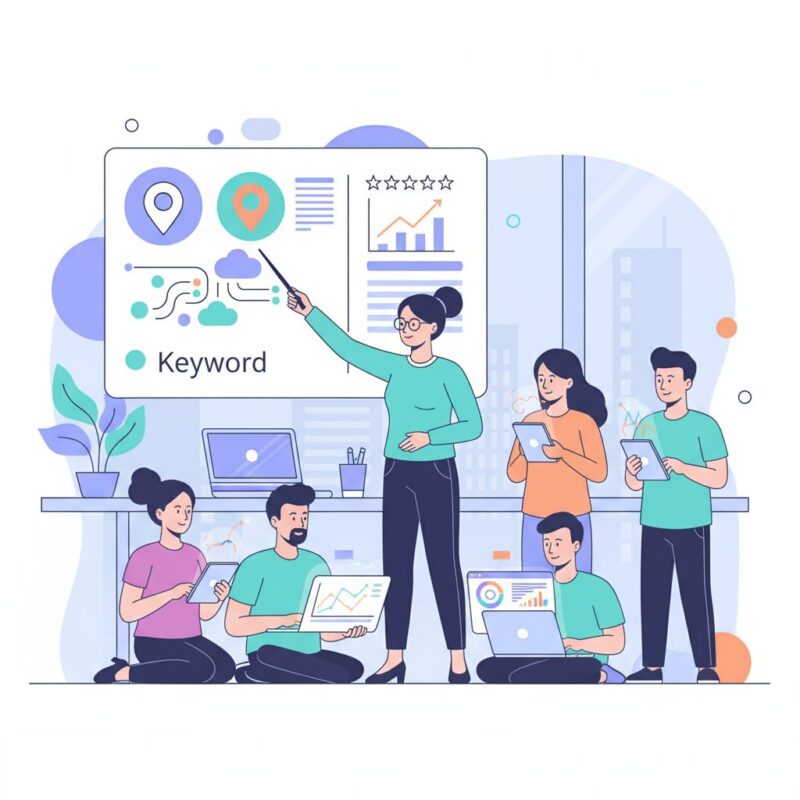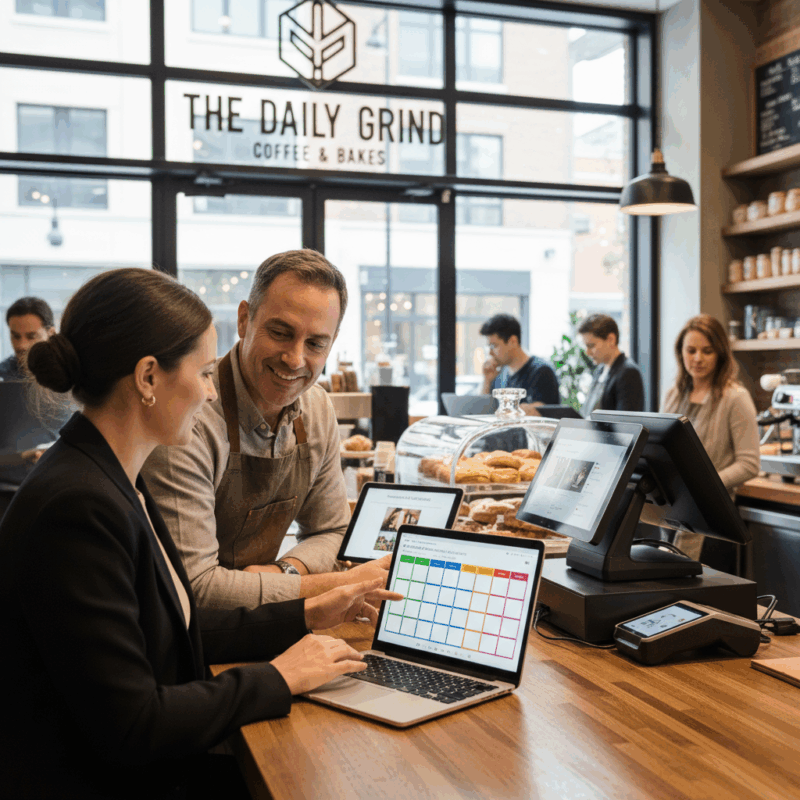- Advanced Local SEO Strategies
- Fundamentals of Local SEO
- Google Business Profile (GBP) Optimization
- Local Keywords and Content Strategy
- Local Link Building
- Local Paid Advertising
- Local Search Ranking Factors
- Local SEO Best Practices
- Local SEO Tools and Analytics
- Local Social Media Marketing
- Online Reviews and Reputation Management
- Technical SEO for Local Businesses
What is the Local Pack Algorithm?

Every second, 40,000 people ask Google questions. Nearly half want nearby solutions. That’s 18,400 searches per second hunting for businesses like yours. But here’s the kicker: 93% of those searches show three map-linked results deciding who gets customers.
This three-business display isn’t random. A specialized system filters relevance, proximity, and reputation. Unlike standard search rankings, it prioritizes real-world signals. Your address accuracy matters as much as customer reviews here.
Visibility in these spots isn’t just nice—it’s necessary. Miss the top three, and 75% of searchers might never find you. But those who crack the code see calls increase by 35% on average. This guide reveals how to become your area’s go-to choice.
Key Takeaways
- Three map-based listings dominate 93% of location-specific searches
- Google processes 46% of all searches with neighborhood-focused intent
- Ranking factors differ from traditional organic search metrics
- First-page visibility increases customer contact rates by 35%
- Optimization requires balancing digital presence and physical location data
Introduction to Local Search Visibility
Mobile users check maps 6+ times daily when seeking nearby solutions. This urgency creates a battleground where visibility determines survival. Google’s systems now prioritize immediate needs, rewarding companies that align with real-time consumer behavior.

Understanding Local Search Intent
Search engines detect location needs through three signals:
- Exact city/neighborhood names in queries
- “Near me” searches using device GPS
- General phrases paired with user location data
Half of mobile users visit stores within a day after searching. 78% make purchases offline, proving these searches drive foot traffic.
The Importance of Local SEO for Your Business
Traditional SEO focuses on broad rankings. Local optimization targets hyper-specific audiences. Compare core differences:
| Traditional SEO | Local SEO |
|---|---|
| National keywords | City-specific phrases |
| Domain authority focus | Google Business Profile optimization |
| Backlink quantity | Local citations & reviews |
Optimizing for neighborhood searches boosts discovery by 4x. Companies appearing in map results gain 5x more calls than those relying solely on organic rankings. This approach turns digital presence into physical customers.
What is the local pack algorithm?
Three businesses dominate 93% of location-based queries through a specialized filtering process. This system, often called the Google Map Pack, evaluates real-time signals to serve hyper-relevant options. Unlike standard organic listings, it prioritizes immediate accessibility over broad authority metrics.
You’ll hear this feature referred to as the Snack Pack or Local 3-Pack in marketing circles. These names all describe the same trio of map-linked listings. Their positions shift dynamically based on searcher location, business hours, and review freshness.
Google’s neighborhood ranking formula cross-checks dozens of factors simultaneously. It verifies your address against third-party directories while analyzing keyword matches in profiles. Recent customer interactions weigh heavier here than domain age or backlink volume.
No company can pay for priority placement – positions get earned through optimization. The system updates every few hours, making consistency crucial. Missing details or conflicting citations could drop visibility overnight.
Only three slots exist per search, creating fierce competition. Winners gain 5x more calls and walk-ins than businesses below the fold. This system rewards those who maintain accurate profiles and actively manage customer feedback.
History and Evolution of the Local Pack
Before 2015, Google displayed seven business listings for location-based searches. These appeared as a basic text list, lacking maps or visual references. Users had to click through multiple pages to compare options.

From the Local 7-Pack to the Local 3-Pack
Google’s 2015 redesign revolutionized local search. The update condensed seven listings into three prime spots with integrated maps. Mobile screens drove this change – three results fit better on smaller displays while maps provided instant location context.
The shift forced businesses to compete harder for visibility. Previously, ranking seventh still meant appearing on the first page. Now, missing the top trio often means obscurity. Simultaneously, maps transformed user behavior – 68% interact with map markers before visiting websites.
This evolution reflects Google’s focus on immediate action. Integrated maps help users visualize distances, while condensed results reduce decision fatigue. Modern optimization strategies now emphasize precise location tagging and photo-rich profiles to stand out visually.
Though controversial initially, the 3-pack format improved mobile satisfaction rates by 41%. It also pushed companies to maintain accurate business data across platforms. Today’s local search dominance requires understanding this historical pivot toward visual, geography-first results.
Key Factors That Influence Local Pack Rankings
Three pillars determine your position in map-based search results. Google’s system balances location accuracy, search alignment, and reputation signals to select winners. Master these elements to outrank competitors in your service area.
Relevance: Matching Your Business to the Query
Your profile must mirror what searchers need right now. Google cross-references these elements:
- Service categories listed in your profile
- Keywords in reviews and posts
- Business description details
Update hours during holidays to match “open now” searches. Include neighborhood names customers use, not official zoning terms.
Proximity and Prominence Explained
Distance matters, but service radius settings can expand your reach. Urban businesses compete within 2-mile zones, while rural areas get 10-mile consideration. Verified addresses beat approximate locations every time.
Prominence measures digital reputation through:
- Review frequency and star ratings
- Citations on industry directories
- Social media mentions
A bakery with 100 authentic reviews often beats one with 500 generic ratings. Consistency across platforms proves legitimacy to ranking algorithms.
These factors work together dynamically. Strong relevance can outweigh moderate proximity. Exceptional prominence might override both. Regular profile updates keep all elements optimized for maximum visibility.
Optimizing Your Google Business Profile
Your digital storefront begins with claiming your Google Business Profile. This free tool acts as your 24/7 sales rep, answering queries and directing customers. Profiles with complete details receive 7x more clicks than incomplete listings.
Claiming and Verifying Your Profile
Start by searching Google for your company name + “manage profile.” Click “Claim this business” if it exists, or create a new listing. Verification typically involves receiving a postcard with a 5-digit code at your physical address within 14 days.
Unverified profiles appear lower in results. Google prioritizes confirmed locations to prevent fake listings. Postcard verification proves you control the premises, a critical trust signal for both users and algorithms.
Completing and Updating Your Business Information
Treat your profile like a first date – missing details create doubt. Required fields form the foundation, but optional sections boost visibility. Compare essential vs recommended elements:
| Information Type | Required | Recommended | Impact |
|---|---|---|---|
| Business Hours | Yes | Holiday Hours | 37% CTR Increase |
| Service Areas | No | 25-mile Radius | 29% More Inquiries |
| Photos | 1 Minimum | 10+ Images | 42% Profile Views |
| Attributes | No | Wheelchair Access | 19% Filtered Searches |
Select primary categories carefully – they determine which searches trigger your listing. A pizzeria using “Italian Restaurant” instead of “Pizza Delivery” misses 68% of relevant queries. Update menu items seasonally and respond to Q&A within 24 hours.
Monthly profile audits prevent outdated information from sinking rankings. Address changes take 48 hours to update across Google’s systems. Consistent NAP (Name, Address, Phone) data builds algorithmic trust over time.
Leveraging Local Citations and Backlinks
Inconsistent business details act like roadblocks in local search results. Search engines cross-reference your information across hundreds of platforms to verify legitimacy. One mismatched phone number or street abbreviation can trigger algorithmic distrust.

Why Uniform Details Matter Everywhere
Google uses third-party directories as truth-checkers. When your name, address, and phone number match Yelp, Facebook, and industry-specific listings, it confirms your physical presence. Discrepancies create confusion – is your salon at “123 Main St” or “123 Main Street Suite B”?
Prioritize these platforms for maximum impact:
- Google Business Profile
- Apple Maps Connect
- Bing Places
- Industry associations (BBB, Chamber of Commerce)
Mismatched data causes 27% of ranking drops in map results. Use tools like BrightLocal to scan for inconsistencies. Correct variations like “Ave” vs “Avenue” in all business profiles. Update your website footer and contact page first – search engines check these pages first.
| Correct NAP | Inconsistent NAP | Impact |
|---|---|---|
| Same phone area code | Mixed 800/local numbers | 41% trust loss |
| Exact street spelling | “St” vs “Street” | 22% ranking drop |
| Current hours listed | Outdated holiday schedule | 37% fewer clicks |
Ongoing monitoring prevents new errors. Set quarterly reminders to audit listings across key platforms. Remember: 68% of customers abandon businesses with conflicting online information. Consistent citations build both search credibility and consumer confidence.
Enhancing Your Website for Local SEO
Your website acts as a digital storefront that either welcomes or repels neighborhood customers. While Google Business Profiles handle immediate visibility, your site builds lasting authority. Proper technical setup helps search engines understand your geographic focus and service capabilities.
On-Page Optimization with Local Keywords
Strategic keyword placement turns generic pages into location magnets. Start with title tags – include city names and service areas upfront. “Denver Roofing Experts | Same-Day Repairs” outperforms vague headers like “Quality Roofing Services.”
Headers and content should naturally integrate neighborhood references. Mention nearby landmarks, transit routes, or local events. A bakery might highlight “Wedding Cakes for Central Park Events” rather than generic dessert descriptions.
Multi-location businesses need targeted landing pages. Create unique content for each service area:
- Phoenix HVAC Services: “24/7 AC Repair in Desert Ridge”
- Houston Plumbing: “Bay Area Pipe Leak Specialists”
These pages avoid duplicate content issues when you customize:
| Element | Generic Version | Localized Version |
|---|---|---|
| Meta Description | “Trusted electricians nationwide” | “Miami Beach circuit repair experts since 2012” |
| Service List | “Light fixture installation” | “Outdoor lighting for Coral Gables homes” |
Balance optimization with usability. Pages stuffed with city names read unnaturally. Instead, showcase area-specific case studies. Feature customer testimonials mentioning local streets or landmarks to build authenticity.
Site speed impacts both rankings and conversions. Compress images of your physical location and service vehicles. Mobile-first design ensures seamless browsing for users searching “near me” on smartphones.
Maximizing Customer Reviews and Engagement
Customer opinions shape your digital reputation more than ever. Authentic feedback directly impacts your visibility in map-based results, with recent ratings carrying 23% more weight than older ones. Active review management builds trust with both search algorithms and potential clients.
Collecting Authentic 5-Star Reviews
Timing matters when requesting feedback. Ask satisfied clients immediately after successful transactions when satisfaction peaks. Provide a direct review link in follow-up emails and text messages – this simple step increases participation by 58%.
Train staff to mention review options during checkout. Display QR codes linking to your profile at service counters. These low-effort methods generate organic testimonials without pressure. Never offer incentives for ratings, as fake endorsements can trigger penalties.
Effective Response Strategies
Reply to every comment within 48 hours. Thank positive reviewers using specific details from their experience. For critical feedback, acknowledge concerns and offer solutions privately. Public responses demonstrate accountability – 64% of users revise negative opinions when businesses address issues constructively.
Update review responses quarterly to reflect seasonal changes. Highlight recurring compliments in marketing materials to reinforce strengths. Consistent engagement shows algorithms your active participation, boosting prominence in competitive markets.
Contact Information
Ready to transform your visibility in neighborhood searches? Our team helps companies stand out where customers look first. Connect with specialists who speak the language of modern search systems.
SEO Local
Phone: 858-201-7994
Email: que@seolocal.it.com
Access proven strategies for profile optimization and location-based marketing. We analyze your current digital presence, then implement tailored solutions that align with ranking requirements.
Services focus on:
- Precision profile updates to boost map visibility
- Review management systems that build trust
- Location-specific content creation
Provide accurate address details and consistent business information across platforms. Our approach combines technical expertise with real-world results, helping you appear where searches happen.
FAQ
How does proximity affect rankings in the Google local pack?
Proximity determines how close your business is to the searcher’s location or the area specified in their query. Google prioritizes nearby businesses, especially for “near me” searches or location-specific keywords. Accurate address details in your Google Business Profile improve visibility for local customers.
Why are customer reviews critical for local pack rankings?
Reviews signal trust and credibility to Google’s algorithm. Businesses with recent, authentic 5-star reviews often rank higher. Responding professionally to feedback also boosts engagement, showing Google your commitment to customer satisfaction.
What role do local citations play in local SEO?
Citations from reputable directories like Yelp or Yellow Pages validate your business’s legitimacy. Consistent Name, Address, and Phone Number (NAP) details across platforms strengthen relevance and prominence, two core ranking factors in the local pack algorithm.
How can businesses optimize their websites for local search visibility?
Include location-based keywords in titles, meta descriptions, and content. Create dedicated service-area pages with local schema markup. Ensure mobile-friendliness and fast load times, as user experience impacts rankings in map pack results.
What’s the difference between the local 7-pack and 3-pack?
Google reduced displayed results from seven to three listings in 2015 to streamline mobile searches. The 3-pack emphasizes relevance, distance, and prominence. This shift prioritized businesses with complete profiles, positive reviews, and strong local SEO signals.
How often should you update your Google Business Profile?
Regularly refresh hours, photos, services, and posts to keep information current. Seasonal updates, promotions, or event announcements signal activity to Google’s algorithm, improving ranking potential in local search results.














